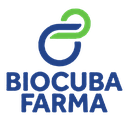Executive Secretary

VIII International Symposium on Chemistry and Pharmaceutical Sciences
SICF
VIII Symposium "Design, Obtaining and Development of Drugs"
Abstract
A recombinant receptor binding domain (RBD) of SARS-CoV2 spike protein in a dimeric form is the antigen in the Soberana 01 and Plus vaccines. This construct contains two polypeptides with the sequence 319-541 of the spike, bridged by an intermolecular disulfide bond between cysteines 538. In the fermentation process only a fraction of the RBD naturally dimerize, since thiol-containing metabolites caps the unpaired cysteine. The aim of this work is to establish a chemical procedure for converting the monomeric RBD into its dimeric form as an additional source of vaccine antigen. For this, the capping of cysteine 538 in the monomer was selectively removed by reduction with TCEP and washed out. Then dimerization was studied with or without oxidants. Dimers were purified by SEC and the selected one was further characterized in order to assure comparability with the productive RBD dimer. SEC-HPLC and SDS-PAGE allowed verifying an increase in dimer proportion up to 50-60 % without any supplementary reagent. Variation in concentration and temperature did not affect results. Addition of oxidants (ie. DSMO and dehydroascorbate) does not improve yield, except for Cu2+ which offers an additional 10%. Conversely, only batches obtained without oxidant did conserve full antigenicity as ACE2 recognition. Characterization by SEC-HPLC, SDS-PAGE, MS, DLS, CD and dot-blot showed similar results respect to naturally occurring dimer. In summary, it is possible to chemically obtain RBD dimer starting in its monomeric form, preserving the natural antigen characteristics.
Resumen
Un dominio de unión a receptor (RBD) de la espícula del SARS-CoV2 recombinante dimérico es el antígeno de las vacunas Soberana 01 y Plus. Esta construcción contiene dos secuencias polipeptídicas 319-541 de la proteína S, unidas por un puente disulfuro a través de la cisteína 538. En el proceso de fermentación solo una fracción del RBD dimeriza de manera natural, debido a que los metábolitos con grupos tioles bloquean la cisteína no pareada. El objetivo de este trabajo es establecer un procedimiento químico para la conversión del RBD monomérico a su forma dimérica como fuente adicionar de antígeno para vacunas. Para esto, el bloqueo de la cisteína 538 en el monómero fue removido selectivamente por reducción con TCEP. Así la dimerización se estudió con o sin oxidantes. Algunos dímeros fueron purificados por SEC y el seleccionado se caracterizó para asegurar su comparabilidad con el dímero productivo. Mediante SEC-HPLC y SDS-PAGE se verificó un incremento en la proporción de dímero hasta 50-60% sin ningún reactivo adicional. La variación de la concentración y la temperatura no alteraron los resultados. La adición de oxidantes (ie. DMSO, dehidroascorbato) no mejoró el rendimiento, excepto el Cu2+ el cual aportó un 10% más. De hecho, solo los lotes obtenidos sin oxidante conservaron completamente la antigenicidad (reconocimiento de ACE2). La caracterización por SEC-HPLC, SDS-PAGE, MS, DLS, CD y dot-blot mostraron resultados similares respecto al dímero natural. En breve, es posible de obtener químicamente RBD dímero a partir del monómero, conservando las características del antígeno natural.
About The Speaker

Jean Pierre Soubal

Discussion




